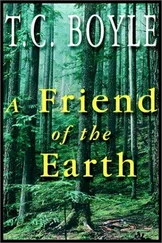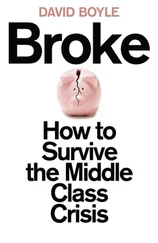“No,” he hears himself say, and he’s not going to get worked up here, he’s not. “No, we didn’t see any sign.”
Sickafoose measures out one of his long big-knuckled fingers and directs their attention to a white enameled sign the size of a regulation backboard, the squared-off admonitory letters stamped there in take-no-prisoners red. How had he missed it? Not that it would have mattered. This is public land, reserved for the public, owned by the public.
“So what are you,” Dave says, “some kind of cop?”
“I’m a biologist.”
“Congratulations.”
Sickafoose ignores him. He’s got something in his hand, in the palm of his hand, which opens in a kind of slow phalangeal striptease on a spatter of rust-red cat kibble and pale yellow vitamin tabs, even as Wilson tugs at the brim of his cap and says, “Well, we got to be going, see you later, man,” and starts for the ladder.
“One minute,” Sickafoose says. The hand thrusts forward. “You know what these are?”
He can feel it now, the quickening pulse of that rage the drugs can only snatch at, and it’s all he can do to stop himself from spitting at the guy’s feet. “Uh-uh,” he says, the voice threshed in his throat. “Never saw them before.”
A beat. Wilson has his hands on the ladder, ready to kick down into the boat, in retreat, and that’s what he should do too — just get out of here and forget it. “You know it’s against the law to feed the wildlife in a national park?” Sickafoose says. “If that’s what you were doing. This is food, right?”
Another beat. Longer. Much longer. He’s thinking of the rat he saw along the road one sorrowful morning, huddled there in the tight binding robe of its agony, a perfect being, perfectly made, every detail of it alive in his memory, the pale exquisitely shaped fingers and toes, whiskers brushed back as if they’d been groomed, the suppleness of the nose, the dark bloodied holes of the nostrils and the pits of the suffering eyes, all of it senseless and wrong, wrong, wrong. All he says is this: “You going to step aside or what?”
Then they’re in the dinghy. Then the boat. Then the rain comes, washing across the surface in a series of sweeps that bring the waves to a boil, and forget the champagne, forget the whole thing, because the engine selects this moment, out of all the myriad others since he’s owned, maintained and piloted the Paladin up and down the coast and out to the islands and back in every sort of weather and the most violent of seas, to fail.
I n the mid-1950s, when the indigenous birds of Guam began to dwindle in number, and then, in the sixties and seventies, to disappear altogether, no one could trace the cause. Researchers serially suspected DDT, herbicides, habitat loss and disease, but it wasn’t until the early eighties that Julie Savidge, a graduate student doing field work for her Ph.D., focused on a hitherto little-noticed reptile that first appeared on Guam just after World War II. The brown tree snake, native to Australia, Malaysia and New Guinea, was thought to have arrived as a stowaway in a crate of munitions, the engine compartment of a military vehicle or perhaps the wheel well of a Navy transport plane. Its appearance had been duly recorded but very few people came into contact with it. Nonetheless, having eliminated the other possible causes, Savidge decided to plot the snake’s spread from the main port at Apra to the southern, eastern and northern verges of the island, and found that she was able to correlate its expansion with the progressive topographical decline of the island’s avifauna. The mystery had been solved. The problem remained.
In fact, when the brown tree snake reached the island, it found itself in an ophidian paradise. The only other species of snake on Guam, an innocuous thing the size of an earthworm, was no competition at all, and there were no predators to limit its numbers. The food supply, consisting of some eighteen species of birds found nowhere else in the world, was rich and abundant, and the birds, in common with other insular species, suffered the sort of naïveté to predation that had doomed the dodo and its ilk. Boiga irregularis lives in equilibrium with the other species in its native environment, and isn’t particularly impressive or dangerous as snakes go. For one thing, its venom, distributed through fangs located at the back of the throat, is relatively mild and only marginally a threat to humans. For another, it is nocturnal and thus rarely seen, and so reedy — no thicker around than a man’s index finger until it reaches a length of three feet or so — as to pale in comparison with some of the snakes of the continental tropics, the cobras, boomslangs, mambas and water moccasins that slither through the herpetophobe’s nightmares.
Still, it has proven to be one of the most insidious and successful invaders on record, reducing those eighteen species of unique birds to eleven, of which two — the Guam rail and the Micronesian kingfisher — exist only in captivity, while six are considered rare and three uncommon. The snake’s density — up to 13,000 per square mile — is among the highest recorded densities of any snake anywhere, and it has proven infinitely adaptable, feeding quite happily on the island’s native frogs and lizards in the absence of the birds, as well as snapping up introduced geckos, skinks, cane toads and just about anything else it can work its jaws around. It grows to some ten feet in length. It appears in toilets, showers, infants’ cradles. Since 1978, 12,000 power failures have been attributed to its climbing electrical poles and shorting out the carrying wires — unintentionally, of course, but knocking out lights, computers and refrigerators all the same. Above all things, it is a climber. A great and undaunted and increasingly voracious climber that has adapted its diet to include pet food as well as pets — in one documented case, a three-week-old golden retriever pup — and anything, alive or dead, that carries the scent of meat. Or blood.
Alma is reminded of all this by the printout—“The Use of Acetaminophen in Controlling Boiga irregularis Among Insular Populations”—spread open beside her laptop on one of the gently rocking Formica tables in the main cabin of the Islander , bound for Anacapa. Sipping coffee from a paper cup and staring into the computer screen as the neatly marshaled lines of type hypnotically rise and descend along with the tabletop and the deck and hull beneath it, she’s not yet aware she has a headache coming on, but every sixty seconds or so she looks reflexively away from the screen and out over the water so as to refocus her eyes. Then she comes back to the text, hits the backspace key and inserts a new phrase or extends a line, her lips silently forming the words. She’s frowning but unaware of it.
The boat’s carrying capacity, both in the cabin and on the upper and stern decks, is a hundred-fifty or so, and today, eighty-five of the spots have been reserved for NPS employees and assorted biologists, including Tim, who are part of the Anacapa Recovery Program, as well as a collection of journalists from the AP, the Los Angeles Times and the Santa Barbara Press Citizen , a dozen local politicians and tastemakers and a television crew from the local NBC affiliate. In the ship’s hold are three big coolers chock-full of marinated chicken, turkey sausage and tofu burgers for the barbecue grill, various salads, whole-grain breads, a pot of chili and rice, a fourth cooler of bottled water, soft drinks and dessert, and a fifth reserved exclusively for champagne. Two cases. On ice. Medium-priced California stuff, as befits the Park Service budget, but champagne — or, more properly, sparkling wine — all the same.
Читать дальше












